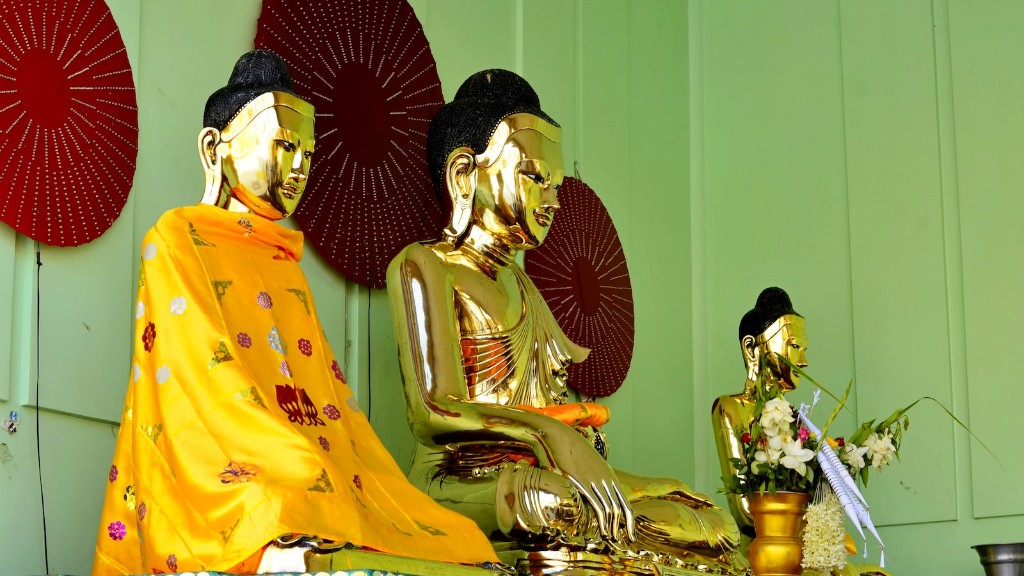Buddhism is a religion and philosophy that originated in India. The main principle of Buddhism is that people can escape suffering by following the path of the Buddha. There are many different practices associated with Buddhism, such as meditation, ethical behavior, and compassion for all beings.
Some of the practices of Buddhism include:
– right speech: avoiding gossip, slander, and lying
– right action: refraining from harming living beings, taking what is not given, and engaging in sexual misconduct
– right livelihood: avoiding jobs that cause harm, such as being a soldier or working in the slaughterhouse industry
– right effort: making a concerted effort to practice meditation and develop positive qualities such as generosity and compassion
– right mindfulness: paying attention to one’s thoughts, emotions, and actions in order to develop a clear understanding of self and reality
– right concentration: training the mind to focus single-pointedly on an object such as the breath in order to develop tranquility and clarity
What are the 4 main practices of Buddhism?
The Four Noble Truths are the foundation of Buddha’s teachings, and though they don’t explain everything, they provide a good starting point for understanding the Buddhist path. The first truth is that suffering exists and is an inescapable part of life. The second truth is that the cause of suffering is our own attachment and clinging to things that are impermanent. The third truth is that there is an end to suffering, and the fourth truth is that there is a path that leads to the end of suffering.
The threefold path of śīla, samadhi, and prajna is the Buddha’s framework for the practice of the Dharma. In this framework, śīla is the foundation, samadhi is the main practice, and prajna is the goal.
What are the 5 main practices of Buddhism
The Five Precepts are basic guidelines for living a moral and ethical life. They are: refrain from taking life, refrain from taking what is not given, refrain from the misuse of the senses, refrain from wrong speech, and refrain from intoxicants that cloud the mind.
Meditation is a key part of Buddhist practice. It is used as a way to open oneself up to a higher state of awareness. Through meditation, Buddhists can connect with their innermost thoughts and feelings.
Bowing is another important part of Mahayana Buddhist practice. It is often done as a sign of respect to the Buddha. Buddhists may also leave offerings, such as gifts, as a mark of respect and reverence.
Where is Buddhism mostly practiced?
Approximately 50% of the world’s Buddhists live in China. Other large Buddhist populations are found in Thailand (13%), Japan (9%), Burma (Myanmar) (8%), Sri Lanka (3%), Vietnam (3%), Cambodia (3%), South Korea (2%), India (2%), and Malaysia (1%).
Buddhism is one of the largest religions in the world with about 400 million followers. It is a religion that does not worship a deity, but instead focuses on teaching about the Four Noble Truths and the Eightfold Path. Buddhism has spread throughout the world, with large populations in countries like China, Japan, and Thailand.
What are the eight practices of Buddhism?
The Buddha teaches that the Noble Eightfold Path is the path to liberation from suffering. The path consists of Right View, Right Resolve, Right Speech, Right Action, Right Livelihood, Right Effort, Right Mindfulness, and Right Concentration. Right View is understanding the Four Noble Truths. Right Resolve is letting go of attachments and aversion. Right Speech is speaking truthfully, kindly, and helpful words. Right Action is acting in ways that are kind and helpful. Right Livelihood is earning one’s living in a way that does not cause harm. Right Effort is making a commitment to practice the path and persevere in the face of difficulties. Right Mindfulness is paying attention to one’s thoughts, emotions, and actions in the present moment. Right Concentration is training the mind to remain focused on one object, such as the breath.
Buddhism is a religion that is based on the teachings of Siddhartha Gautama, also known as the Buddha. One of the most important things that the Buddha taught was the Four Noble Truths. These truths are essential to understanding the religion and its central tenet of avoiding suffering. The Four Noble Truths are:
1. All life is suffering.
2. Suffering is caused by attachment to things that are impermanent.
3. Suffering can be eliminated by eliminating attachment.
4. The path to eliminating attachment is the Eightfold Path.
The Eightfold Path is a set of guidelines that Buddhists can follow in order to end their suffering. The path includes things like right understanding, right thought, and right action. By following these guidelines, Buddhists believe that they can escape the cycle of rebirth and achieve Nirvana.
What are the 10 rules of Buddhism
The Ten Grave Precepts, also known as the Ten Great Principles, are a set of moral guidelines for Buddhist practitioners. The precepts are: respect life, do not kill; be giving, do not steal; honor the body, do not misuse sexuality; manifest truth, do not lie; proceed clearly, do not cloud the mind; see the perfection, do not speak of others’ errors and faults; realize self and others as one, do not elevate the self and blame others.
Buddhism is a religion and philosophy that promotes peace, compassion and wellbeing. It is based on the teachings of the Buddha, who lived over 2,500 years ago in India.
Buddhism can be practiced in daily life by anyone, regardless of religious beliefs. There are many ways to do this, but some common practices include meditation, mindfulness and offering kindness to others.
Meditation is a key part of Buddhism, and it can be done in many different ways. One way to meditate is to focus on the breath, and simply allow the mind to become calm and relaxed. Another way is to focus on a mantra, or a repeated word or phrase, which can help to quiet the mind.
Mindfulness is about being present in the moment and paying attention to our thoughts, emotions and sensations. It can help us to become more aware of our own mind and body, and can be practiced in many different ways.
Offering kindness to others is another key part of Buddhism. This can be done in small ways, such as smiling at someone, or in bigger ways, such as volunteering for a local charity. By helping others, we can cultivate a kind heart and make the world a more compassionate place.
What are modern Buddhist practices?
Buddhist modernism is a trend that began in the late 19th century and continues today. It is characterized by an emphasis on texts, rationality, meditation, egalitarianism, and increased participation of women and laity, along with a deemphasis on ritual, dogma, clerical hierarchy, “superstition,” traditional cosmology, and icon worship.
In order to “practice” Buddhism, one does not need to do anything fancy or out of the ordinary. Instead, it is recommended that one simply lives their life in accordance with the Buddha’s teachings. This means being kind and compassionate to others, being honest and truthful, and living a life of moderation. If one can do this, then they are said to be “practicing” Buddhism.
What is the Buddhist way of life
The ‘Middle Way’ is a practical approach to life which helps us to progress on the path to self-development. It comprises the Noble Eight-fold Path which helps us to develop the Right Understanding, Right Thought, Right Speech, Right Action, Right Livelihood, Right Effort, Right Mindfulness and Right Concentration.
Buddhism is a religion that is based on the teachings of the Buddha. Buddhism teaches that there is no one god that created everything, but instead that all beings have the potential to achieve enlightenment. Buddhists strive to follow the Middle Way, which is a path of moderation between the extremes of self-indulgence and self-mortification.
Do Buddhists eat meat?
There are many different interpretations of the Buddhist dietary restriction against killing. Some Buddhists interpret this to mean that you should not consume animals, as doing so would require killing. Buddhists with this interpretation usually follow a lacto-vegetarian diet, which means they consume dairy products but exclude eggs, poultry, fish, and meat from their diet.
China has the largest population of Buddhists in the world, at approximately 244 million, or 182% of its total population. The vast majority of Chinese Buddhists are followers of Chinese schools of Mahayana Buddhism, making this the largest body of Buddhist traditions. Interestingly, although Buddhism originally came to China from India, it has since heavily influenced the development of Chinese culture and society, and Vice versa.
Warp Up
There are many different practices associated with Buddhism, depending on the particular tradition or school. Some common practices include meditation, mindfulness, ethical living, and study of the Buddha’s teachings.
Although there are many different practices associated with Buddhism, some of the most common include meditation, mindfulness, and compassion. By incorporating these practices into their daily lives, Buddhists strive to live in a way that is in alignment with their beliefs. By learning to be present in the moment and to develop compassion for all beings, Buddhists hope to create a more peaceful world for everyone.



